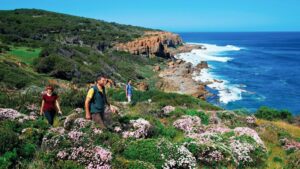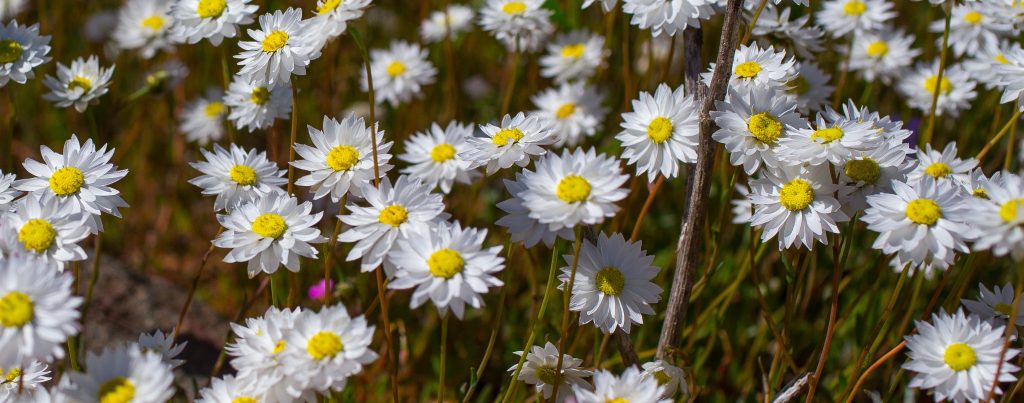You can wonder at the wildflowers as they bloom in the North from June and then follow them down to the South until November… or you can wait for them to come to you!
Either way, make sure you check out WA’s wildflowers in what is looking to be a blooming wonderful wildflower season in 2021.
WA is renowned for its spectacular flourishes of native colour with more than 12,000 species of wildflowers. This makes it the largest collection in the world, and it is an amazing sight to behold, especially considering that more than 60% of Western Australian wildflowers are not found anywhere else in the world!
Read on for a guide on when to expect the wildflowers to bloom in various regions around WA.
Australia’s North West June – September
Wildflowers and flowering trees can be seen in The Kimberley throughout the dry season and although it doesn’t display the same grand colours as The Pilbara, it is still very special with immensely adaptive flora that copes with intense rainfall and very dry conditions.
The Pilbara comes alive from July to September with vibrant flowers contrasting with the dusty red earth and golden spinifex grass.
There are over half a million square kilometres of diverse landscapes and the wildflowers show the same amazing range. You can find the iconic Sturt’s desert pea, fluffy Mulla Mulla, the majestic Ashburton pea, or any number of the 65 species of Acacia (wattle) that can be seen throughout the region.
For the local Indigenous people, the plants and flowers of the Pilbara are still used today for food, medicine, and ceremonial use.
Karijini National Park is home to a great range of wildflower species and is a great place to visit and marvel at over 500 species of native flora, including some rare species.

Sturt’s desert pea (Photo: Australia’s North West)
Australia’s Coral Coast Late July – Early October
The rural sandplains and bushlands of Australia’s Coral Coast burst with colour from late July to early October.
This region is renowned for the bold blankets of brilliant wildflowers that colour the outback landscape like a patchwork quilt. There are unique individual species in this region that can also be found.
There are lots of great hotspots to visit such as Nambung National Park, Lesueur National Park, Coalseam Conservation Park, Pindar and Mullewa, Kalbarri National Park, Shark Bay World Heritage Area, and Ningaloo Coast World Heritage Area.

Coalseam Wildflowers (Photo: Daniel Wilkins, Tourism WA)
Australia’s Golden Outback July – October
The Gascoyne and Murchison are well-known for carpets of everlastings and they should begin to flourish for a bumper wildflower season in July. Mulla Mulla, acacias, and other bush flowers are already in bloom.
From mid-August, the flowers then start to bloom right across the Wheatbelt, with its beautiful orchids, everlastings, and countless other species. In Spring the landscapes are abuzz with colour and there are so many self-drive trails to explore.
The Northern Wheatbelt and Wildflower Country is known for everlastings, verticordias, the wreath flower, pom poms, and orchid species such as ant, donkey, fairy, pink candy orchids. Central and North-East Wheatbelt has massive outcrops and nature reserves with everlastings and orchid species. In the Southern Wheatbelt, you can see hakea, grevillea and countless types of orchids such as the rare queen of Sheba orchid, as well as other extensive wildflower displays well into September.

Wildflowers at Mount Augustus (Photo: Tourism WA, @RobMulally and @GeorgiaRickard)
Perth Region September – November
Within the Perth region, you can explore the beauty of the native wildflowers in a few nature hotspots. There are several sites around Perth and surrounds that blossom with colour from September to November.
Kings Park, National Parks, botanical gardens, and local nature reserves and bushland might just surprise you with the colours that erupt in the springtime.

Kings Park and Botanic Garden (Photo: Tourism WA)
Australia’s South West August – November
The South West is known for having ecologically significant wildflowers as it is a Biodiversity Hotspot.
Remember when we said WA has 12,000 wildflower species? Well, 8,000 of those can be found in the South West! Witness the explosion of colour set against the stunning natural scenery of the region from August to November.
Almost 80% of the plant species in the region can’t be found anywhere else on Earth and there are some great National Parks and Trails to view an abundance of wildflowers in the springtime.
With Banksia, Dryandras, Acacia, Hovea, Sticky Tailflower, Heaths and Hibbertias, Wattles, an abundance of native orchids, and countless more flora species… there is so much to explore and there are some great top spots to find them.

Cape to Cape Track in Spring (Photo: margaretriver.com)
FINAL TIPS
? Take nothing but photos. Picking wildflowers can be devastating to populations of some species and a photo will last longer. You’ll also avoid a $2000 fine.
? Stick to the paths where possible. If you do venture off-track then be mindful of your feet and be careful not to tread on any precious wildflowers.
? Clean your shoes. Clean and disinfect your shoes when walking between sites to avoid carrying seeds and any pests or diseases.
? Respect private property. Please do not enter private property or farmland, no matter how pretty!



